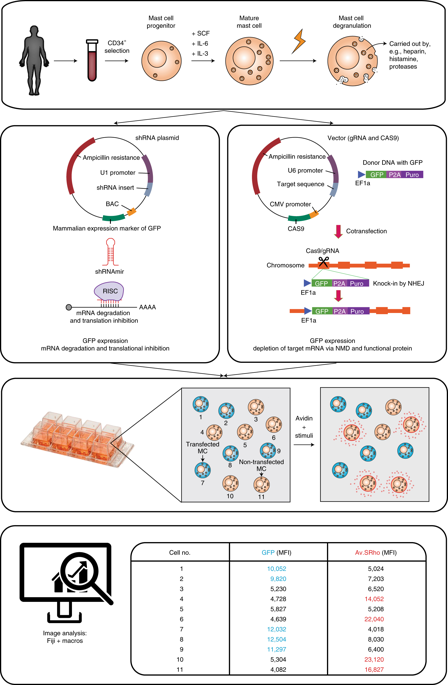当前位置:
X-MOL 学术
›
Nat. Protoc.
›
论文详情
Our official English website, www.x-mol.net, welcomes your feedback! (Note: you will need to create a separate account there.)
Rapid identification of human mast cell degranulation regulators using functional genomics coupled to high-resolution confocal microscopy.
Nature Protocols ( IF 14.8 ) Pub Date : 2020-02-14 , DOI: 10.1038/s41596-019-0288-6 Jelle Folkerts 1, 2, 3 , Nicolas Gaudenzio 4 , Marcus Maurer 2 , Rudi W Hendriks 3 , Ralph Stadhouders 3, 5 , See-Ying Tam 1 , Stephen J Galli 1, 6
Nature Protocols ( IF 14.8 ) Pub Date : 2020-02-14 , DOI: 10.1038/s41596-019-0288-6 Jelle Folkerts 1, 2, 3 , Nicolas Gaudenzio 4 , Marcus Maurer 2 , Rudi W Hendriks 3 , Ralph Stadhouders 3, 5 , See-Ying Tam 1 , Stephen J Galli 1, 6
Affiliation

|
Targeted functional genomics represents a powerful approach for studying gene function in vivo and in vitro. However, its application to gene expression studies in human mast cells has been hampered by low yields of human mast cell cultures and their poor transfection efficiency. We developed an imaging system in which mast cell degranulation can be visualized in single cells subjected to shRNA knockdown or CRISPR-Cas9 gene editing. By using high-resolution confocal microscopy and a fluorochrome-labeled avidin probe, one can directly assess the alteration of functional responses, i.e., degranulation, in single human mast cells (10-12 weeks old). The elimination of a drug or marker selection step avoids the use of potentially toxic treatment procedures, and the brief hands-on time of the functional analysis step enables high-throughput screening of shRNA or CRISPR-Cas9 constructs to identify genes that regulate human mast cell degranulation. The ability to analyze single cells substantially reduces the total number of cells required and enables the parallel visualization of the degranulation profiles of both edited and non-edited mast cells, offering a consistent internal control not found in other protocols. Moreover, our protocol offers a flexible choice between RNA interference (RNAi) and CRISPR-Cas9 genome editing for perturbation of gene expression using our human mast cell single-cell imaging system. Perturbation of gene expression, acquisition of microscopy data and image analysis can be completed within 5 d, requiring only standard laboratory equipment and expertise.
中文翻译:

使用功能基因组学和高分辨率共聚焦显微镜快速鉴定人肥大细胞脱颗粒调节剂。
靶向功能基因组学是研究体内和体外基因功能的有力方法。然而,其在人类肥大细胞中的基因表达研究中的应用由于人类肥大细胞培养物的低产率及其差的转染效率而受到阻碍。我们开发了一种成像系统,其中可以在进行shRNA敲低或CRISPR-Cas9基因编辑的单细胞中可视化肥大细胞脱粒。通过使用高分辨率共聚焦显微镜和荧光染料标记的抗生物素蛋白探针,可以直接评估单个人肥大细胞(10-12周龄)中功能反应的变化,即脱颗粒。消除了药物或标记物选择步骤,避免了使用可能有毒的治疗程序,功能分析步骤的简短动手时间可实现对shRNA或CRISPR-Cas9构建体的高通量筛选,从而鉴定出调节人肥大细胞脱粒的基因。分析单个细胞的能力大大减少了所需细胞的总数,并使编辑和未编辑的肥大细胞脱颗粒图的并行可视化成为可能,从而提供了其他方案中找不到的一致的内部控制。此外,我们的协议提供了在RNA干扰(RNAi)和CRISPR-Cas9基因组编辑之间的灵活选择,以使用我们的人类肥大细胞单细胞成像系统干扰基因表达。基因表达的扰动,显微镜数据的采集和图像分析可在5天内完成,仅需标准实验室设备和专业知识即可。
更新日期:2020-02-14
中文翻译:

使用功能基因组学和高分辨率共聚焦显微镜快速鉴定人肥大细胞脱颗粒调节剂。
靶向功能基因组学是研究体内和体外基因功能的有力方法。然而,其在人类肥大细胞中的基因表达研究中的应用由于人类肥大细胞培养物的低产率及其差的转染效率而受到阻碍。我们开发了一种成像系统,其中可以在进行shRNA敲低或CRISPR-Cas9基因编辑的单细胞中可视化肥大细胞脱粒。通过使用高分辨率共聚焦显微镜和荧光染料标记的抗生物素蛋白探针,可以直接评估单个人肥大细胞(10-12周龄)中功能反应的变化,即脱颗粒。消除了药物或标记物选择步骤,避免了使用可能有毒的治疗程序,功能分析步骤的简短动手时间可实现对shRNA或CRISPR-Cas9构建体的高通量筛选,从而鉴定出调节人肥大细胞脱粒的基因。分析单个细胞的能力大大减少了所需细胞的总数,并使编辑和未编辑的肥大细胞脱颗粒图的并行可视化成为可能,从而提供了其他方案中找不到的一致的内部控制。此外,我们的协议提供了在RNA干扰(RNAi)和CRISPR-Cas9基因组编辑之间的灵活选择,以使用我们的人类肥大细胞单细胞成像系统干扰基因表达。基因表达的扰动,显微镜数据的采集和图像分析可在5天内完成,仅需标准实验室设备和专业知识即可。


























 京公网安备 11010802027423号
京公网安备 11010802027423号